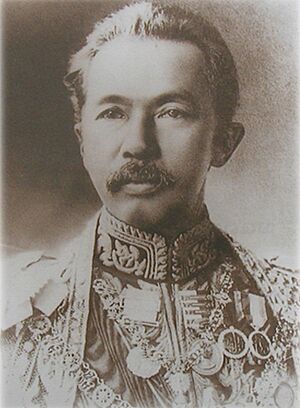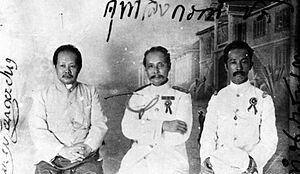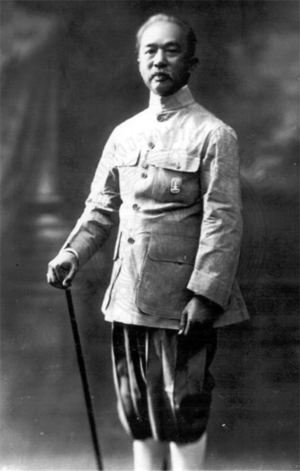Damrong Rajanubhab facts for kids
Quick facts for kids Tisavarakumarnดิศวรกุมาร |
|||||
|---|---|---|---|---|---|
| Prince Damrong Rajanubhab | |||||

HRH Prince Damrong Rajanubhab
|
|||||
| Minister of Interior | |||||
| In office | April 1892 – August 1915 | ||||
| Predecessor | None | ||||
| Successor | Choey Kalayanamitr | ||||
| Grand-officer to the Army | |||||
| In office | 8 April 1887 – April 1890 | ||||
| Predecessor | None | ||||
| Successor | Surasakmontri (as the army department commander) |
||||
| Born | 21 June 1862 Bangkok, Siam |
||||
| Died | 1 December 1943 (aged 81) Bangkok, Siam |
||||
| Spouse | 11 consorts | ||||
| Issue | 37 sons and daughters | ||||
|
|||||
| House | Diskul (Chakri dynasty) | ||||
| Father | Mongkut (Rama IV) | ||||
| Mother | Consort Chum | ||||
| Signature | |||||
Prince Tisavarakumarn, also known as Prince Damrong Rajanubhab, was a very important person in Thailand's history. He was born on June 21, 1862, and passed away on December 1, 1943. Many people call him the "father" of modern Thai education and how the country's provinces are managed today.
He was a self-taught historian and one of the smartest people in Thailand during his time. Prince Damrong was a son of King Mongkut (Rama IV). He learned Thai and Pali from private teachers. He also studied English at the Royal School. When he was 14, he went to a special palace school. His half-brother, King Chulalongkorn, created this school.
Prince Damrong started working for the royal government when he was young. At 18, he became the commander of the Royal Guards. He then helped build army schools and made the army more modern. In 1887, he became the commander-in-chief of the army. King Chulalongkorn also chose him to be the Minister of Education.
When King Chulalongkorn started big changes in the government in 1892, Prince Damrong was chosen to lead the Ministry of the North. This ministry later became the Ministry of the Interior in 1894.
Contents
Shaping Thailand: Prince Damrong's Reforms
As a minister, Prince Damrong completely changed how provinces were managed. He combined many small provinces into bigger ones. Provincial governors, who used to have a lot of power, now worked for the ministry. They were appointed and paid by the central government.
He also created a new administrative division called the monthon (circle). Each monthon covered several provinces. He made sure that government staff received proper training. Prince Damrong was one of the King's most important advisors. Many believed he was the second most powerful person after the King.
Challenges in Siam's Government

During this time, Thailand (then called Siam) faced many challenges. Its old laws and ways of governing were hard for foreign countries to understand. The Bowring Treaty, signed earlier, had not helped Siam as much as expected. It even caused some problems. Prince Damrong's reforms faced difficulties, partly because France was also trying to influence Siam.
Finding International Advisors
Prince Damrong traveled to Europe to find a European advisor for the King. In 1891, he met Gustave Rolin-Jaequemyns in Egypt. Rolin-Jaequemyns was an expert in international law. After talking with the King, Prince Damrong offered him a good salary. Rolin-Jaequemyns became a key advisor. Later, other American advisors, many from Harvard Law School, also helped Thailand. They worked under the Foreign Minister, Devawongse Vaprokar.
Leading the Ministry of the Interior
King Chulalongkorn was very impressed with Prince Damrong's skills. He had seen how well Damrong organized the army's equipment. He also saw how he managed schools and the education ministry. Because of this, the King promoted Damrong over his older half-brothers.
In 1892, Prince Damrong became the Minister of the North. This was part of a bigger plan to reform the government. By 1894, his ministry also took over the Southern and Western provinces. It was then renamed the Ministry of Interior.
Modernizing Provincial Management
Prince Damrong changed the ministry a lot. He replaced older officials with people loyal to him. He also made sure that noble families who traditionally governed provinces received formal training. He believed in promoting people based on their skills, not just their family background. This meant that even clerks could get promoted.
He also reorganized the ministry into different departments. These included a central department, a legal department, and a provincial administration department. His ministry also started handling tasks that usually belonged to other ministries. This was because his staff's help was needed for these tasks. Examples include provincial revenue, irrigation, forestry, mines, and even a provincial police force.
The Thesaphiban System
Prince Damrong's most important reform was creating the thesaphiban system. This system made provincial administration more professional. It also made it directly answerable to the central government. The system was named after the thesaphiban or superintendent commissioners. These commissioners oversaw groups of provinces called monthon or circles.
After visiting northern provinces in 1892, Damrong realized that provincial governments were not connected enough to the central government. They needed big changes. Throughout the 1890s, he created monthon and appointed thesaphiban. Administration was divided into judicial (laws), financial (money), and administrative (management) areas. Each thesaphiban had a commissioner for each of these areas.
Prince Damrong and the thesaphiban also reduced the power of local nobles. They took over their sources of income, like court fees and travel taxes. Then, they used some of this money to pay the nobles salaries. These nobles were then brought into the provincial administration. They were often moved to other provinces. This helped break their strong local ties.
The ministry also appointed officials to run districts (smaller areas within provinces). They also had local elders, chosen by the people, take responsibility for keeping peace and collecting taxes in villages. These changes were made official across the country in 1899. This turned provincial governors from semi-independent nobles into officials of the central government. These reforms led to the government collecting twice as much money. They also improved some social services and made the provinces safer.
Later Life and Legacy
After King Chulalongkorn passed away in 1910, Prince Damrong's relationship with the new King, Vajiravudh, was not as good. Prince Damrong resigned from his ministry job in 1915. He said it was due to health problems. This was to avoid showing disrespect to the King.
During the short reign of King Prajadhipok, Prince Damrong suggested that the King create the Royal Institute. This institute would look after the National Library and museums. He became its first president. King Prajadhipok gave him the special title Somdet Phra Chao Borommawong Thoe Krom Phraya Damrong Rajanubhab. This is the name he is usually known by today.
In the years that followed, Damrong worked as a self-taught historian. He also wrote many books about Thai literature, culture, and arts. His work helped create the National Library and the National Museum. He is often called the "father of Thai history." His way of writing history combined old royal records with Western historical methods. This helped create a royal and national history for modern Thailand. While his work is very important, some people now see it as too focused on nationalism.
After the Siamese revolution of 1932, which changed Thailand to a Constitutional monarchy, Prince Damrong was sent away to Penang in British Malaysia. He was a strong supporter of the absolute monarchy. In 1942, he was allowed to return to Bangkok. He passed away one year later.
Prince Damrong is remembered for many things. He is seen as the father of Thai history, the education system, and the health system. The Ministry of Health was originally part of the Ministry of the Interior. He also played a big role in shaping Bangkok's idea of "Thainess".
In 1962, on the 100th anniversary of his birth, he became the first Thai person to be included in the UNESCO list of the world's most distinguished people. On November 28, 2001, the government declared December 1 as "Damrong Rajanupab Day." This day honors his many contributions to the country.
His many descendants use the royal family name Tisakula or Diskul.
Writings
Prince Damrong wrote many books and articles. Here are a few that are available in English:
- Our Wars with the Burmese: Thai-Burmese Conflict 1539–1767, ISBN: 974-7534-58-4
- Journey through Burma in 1936: A View of the Culture, History and Institutions, ISBN: 974-8358-85-2
- Stories of Archeology: A Collection of True Stories, (Title in Thai:นิทานโบราณคดี), ISBN: 978-616-514-533-6
Honours
National Honours
Prince Damrong received many awards and medals from Thailand:
 Thailand:
Thailand:
 Knight of the Order of the Royal House of Chakri (1886)
Knight of the Order of the Royal House of Chakri (1886) Knight of the Order of the Nine Gems (1901)
Knight of the Order of the Nine Gems (1901) Knight Grand Cordon of the Order of Chula Chom Klao (1900)
Knight Grand Cordon of the Order of Chula Chom Klao (1900) Knight of the Ratana Varabhorn Order of Merit (1911)
Knight of the Ratana Varabhorn Order of Merit (1911) Knight Grand Cordon of the Order of the White Elephant (1913)
Knight Grand Cordon of the Order of the White Elephant (1913) Knight Grand Cordon of the Order of the Crown of Thailand (1923)
Knight Grand Cordon of the Order of the Crown of Thailand (1923) Knight of the Vajira Mala Order (1911)
Knight of the Vajira Mala Order (1911) Dushdi Mala Medal Pin of Services to the Monarch (Military) (1893)
Dushdi Mala Medal Pin of Services to the Monarch (Military) (1893) Dushdi Mala Medal Pin of Arts and Science (Military) (1890)
Dushdi Mala Medal Pin of Arts and Science (Military) (1890) Dushdi Mala Medal Pin of Arts and Science (Civilian) (1890)
Dushdi Mala Medal Pin of Arts and Science (Civilian) (1890) Dushdi Mala Medal Pin of Services to the Monarch (Civilian) (1899)
Dushdi Mala Medal Pin of Services to the Monarch (Civilian) (1899) Chakra Mala Medal (1893)
Chakra Mala Medal (1893) Saratul Mala Medal (1925)
Saratul Mala Medal (1925) King Rama IV Royal Cypher Medal (1904)
King Rama IV Royal Cypher Medal (1904) King Rama V Royal Cypher Medal (1908)
King Rama V Royal Cypher Medal (1908) King Rama VI Royal Cypher Medal (1910)
King Rama VI Royal Cypher Medal (1910) King Rama VII Royal Cypher Medal (1926)
King Rama VII Royal Cypher Medal (1926) Queen's Medal (1898)
Queen's Medal (1898) Recipient of the King Rama VII Coronation Medal (1926)
Recipient of the King Rama VII Coronation Medal (1926)
Foreign Honours
He also received honours from other countries:
 Russian Empire:
Russian Empire:
 German Empire:
German Empire:
 Ottoman Empire:
Ottoman Empire:
 Kingdom of Italy:
Kingdom of Italy:
 Kingdom of Greece:
Kingdom of Greece:
 Denmark:
Denmark:
 Grand Cross of the Order of the Dannebrog (1892)
Grand Cross of the Order of the Dannebrog (1892) Knight of the Order of the Elephant (1930)
Knight of the Order of the Elephant (1930)
 France:
France:
 Grand Officer of the Legion of Honour (1892)
Grand Officer of the Legion of Honour (1892)
 Japan:
Japan:
 Grand Cordon of the Order of the Rising Sun (1895)
Grand Cordon of the Order of the Rising Sun (1895)
Images for kids
See also
 In Spanish: Damrong Rajanubhab para niños
In Spanish: Damrong Rajanubhab para niños
- Varadis Palace



